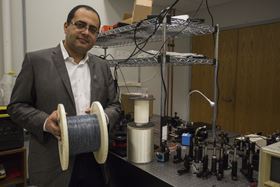 Ayman Abouraddy with a roll of multi-layered fiber. Photo: UCF.
Ayman Abouraddy with a roll of multi-layered fiber. Photo: UCF.A finding by a researcher at the University of Central Florida (UCF) that unlocks a means of controlling materials at the nanoscale and opens the door to a new generation of manufacturing is reported in a paper in Nature.
Using a pair of pliers in each hand and gradually pulling taut a piece of glass fiber coated in plastic, associate professor Ayman Abouraddy found that something unexpected and never before documented occurred – the inner fiber fragmented in an orderly fashion.
"What we expected to see happen is NOT what happened," he said. "While we thought the core material would snap into two large pieces, instead it broke into many equal-sized pieces
The process of pulling fibers to force the realignment of their component molecules, known as cold drawing, has been the standard method for the mass production of flexible fibers like plastic and nylon for most of the last century. While individual parts of those fibers are brittle, once cold-drawn, the fibers toughen up and become useful in everyday commodities. This discovery at DuPont at the end of the 1920s ushered in the age of textiles and garments made from synthetic fibers.
Abouraddy and his team have now shown that this process may also be applicable to multi-layered materials, a finding that could lead to the manufacture of a new generation of materials with advanced properties.
"Advanced fibers are going to be pursuing the limits of anything a single material can endure today," Abouraddy said. For example, packaging together materials with optical and mechanical properties along with sensors that can monitor such vital signs as blood pressure and heart rate would make it possible to make clothing capable of transmitting vital data to a doctor's office via the internet.
The ability to control breakage in a material is also critical for developing computerized processes for manufacturing, said Yuanli Bai, a fracture mechanics specialist in UCF's College of Engineering and Computer Science. Abouraddy contacted Bai, who is a co-author on the paper, about three years ago and asked him to analyze the results of tests on a wide variety of materials, including silicon, silk, gold and even ice.
Abouraddy also contacted Robert Hoy, a University of South Florida physicist who specializes in the properties of materials like glass and plastic, for a better understanding of what he found. Hoy said he had never seen the phenomena Abouraddy was describing, but that it made great sense in retrospect.
According to Hoy, this research has taken what has traditionally been a problem in materials manufacturing and turned it into an asset. "Dr. Abouraddy has found a new application of ‘necking’," he said. "Usually you try to prevent necking, but he exploited it to do something potentially groundbreaking." Necking is a process that occurs when cold drawing causes non-uniform strain in a material.
Only recently have fibers made of multiple materials become possible. They will be the centerpiece of a $317 million US Department of Defense program focused on smart fibers that Abouraddy and UCF will take part in. The Revolutionary Fibers and Textiles Manufacturing Innovation Institute (RFT-MII), led by the Massachusetts Institute of Technology, will incorporate some of the findings reported in the Nature paper, Abouraddy said.
By controlling the mechanical force used to pull the fiber and therefore the breakage patterns, materials can be developed with customized properties. Such materials will be able to interact with each other and with eternal forces such as the sun (for harvesting energy) and the internet in customizable ways.
Ali Gordon, an associate professor in the Department of Mechanical & Aerospace Engineering and a co-author of the paper, said this research shows that, by carefully controlling the loading condition imparted to the fiber, materials can be developed with tailored performance attributes.
"Processing-structure-property relationships need to be strategically characterized for complex material systems. By combining experiments, microscopy, and computational mechanics, the physical mechanisms of the fragmentation process were more deeply understood," he said.
This story is adapted from material from at the University of Central Florida, with editorial changes made by Materials Today. The views expressed in this article do not necessarily represent those of Elsevier. Link to original source.